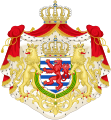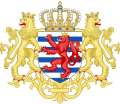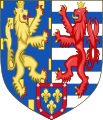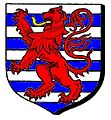Coat of arms of Luxembourg
| Coat of arms of the Grand Duchy of Luxembourg | |
|---|---|
 Greater (royal) version | |
| Versions | |
 The banner of arms, which serves as civil ensign | |
Shield | Barry of ten Argent and Azure, a Lion rampant queue fourchée en sautoir Gules crowned, armed and langued Or. |
| Supporters | Two lions reguardant queue fourchée en sautoir Or crowned of the same, armed and langued Gules |
| Order(s) | Order of the Oak Crown |
| Other elements | The shield is ensigned with the Grand-Ducal crown of Luxembourg. The whole under a Mantle Gules doubled ermine, fringed and tasseled Or, ensigned with the Grand-Ducal Crown |
The coat of arms of
Versions
There are greater, middle and lesser versions of the coat of arms of Luxembourg. The greater coat of arms has two
-
Greater coat of arms (Royal version)
-
Middle coat of arms (State version)
-
Lesser coat of arms
-
variant used on street signs.
Arms of the monarch
The
Quarterly: 1 and 4 Luxembourg, 2 and 3 Nassau (Blazon: Azure billetty Or, a lion or armed and langued Gules). The lesser variant of the arms of the monarch has no external ornaments. The middle variant has the supporters and the crown.
The greater variant has a dynastic inescutcheon with the arms of the
-
Greater coat of arms of the Grand Duke
-
Middle coat of arms of the Grand Duke
-
Lesser coat of arms of the Grand Duke
Historical
The coat of arms adopted by
-
Greater Coat of arms of the Grand Duke
-
Middle coat of arms of the Grand Duke
-
Lesser coat of arms of the Grand Duke
These arms were adopted in 1898 by Grand Duke Adolphe and used by him and his successors up until
Prior to acceding the throne, Grand Duke Jean made use of the following arms:
-
1939
-
1953
Arms of the Hereditary Grand Duke
The current greater and lesser coats of arms for the Hereditary Grand Duke are currently prescribed by grand-ducal decree of 31 October 2012 and are similar to that of the Grand Duke's with the addition of a gold label on the shield for differencing. In the greater arms, the supporters also do not carry flags.[4]
-
Greater coat of arms of the Hereditary Grand Duke
-
Lesser coat of arms of the Hereditary Grand Duke
The coat of arms of Henry V, Count of Luxembourg (1216–1281)
It is uncertain what was the origin of this field barry argent and azure. Jean-Claude Loutsch, Luxembourg's most prominent
-
Coat of arms of Waleran III, Duke of Limburg (Lion of Limburg)
-
Coat of arms of the Counts of Grandpré and Counts of Loon
-
Coat of arms of Henry V, Count of Luxembourg (Lion of Luxemburg)
The coat of arms of Henry VI, Count of Luxembourg (1240-1288)
In 1282, after the death of
-
Coat of arms of the Dukes of Limburg
-
Coat of arms of Henry VI, Count of Luxembourg between 1282 and 1288
-
Coat of arms of the Counts of Luxembourg after 1288
Lusignan and Stratford
-
The Lusignan coat of arms, granted in the 12th century
-
The Luxembourg coat of arms between 1282 and 1288 (Henry VI)
-
The Luxembourg coat of arms after 1288
-
The Stratford type B coat of arms, first recorded in 1543
The Luxembourg Coat of Arms bears a striking similarity to both the arms of Lusignan and of Stratford. The relationship is unknown, if indeed any exists at all although the link between the Lusignan and Luxembourg coat-of-arms is provided in 'Le Roman de Mélusine' by Couldrette whereby a descendant of the legendary founder and faerie queen of Lusignan adopts the burely of 10 argent and azure, adding the lion rampant due to his similarly shaped birthmark. Historians have generated various theories as to the connection between the houses and the arms, none conclusive.[5]
See also
References
- ^ a b Mémorial A, number 114, of 14 September 2001
- ^ Arrêté grand-ducal du 23 février 2001 fixant les petites et les moyennes armoiries de Son Altesse Royale le Grand-Duc[1]
- ^ Arrêté grand-ducal du 23 juin 2001 fixant les grandes armoiries de Son Altesse Royale le Grand-Duc[1]
- ^ Arrêté grand-ducal du 31 octobre 2012 fixant les petites et les grandes armoiries de Son Altesse Royale le Grand-Duc Héritier. Mémorial A, number 236, of 9 November 2012
- ^ Péporté, Pit. "Constructing the Middle Ages: Historiography, Collective Memory and Nation-Building in Luxembourg" pp 80-93. BRILL. (2011)
- Armorial du pays de Luxembourg, Dr. Jean-Claude Loutsch, Publications nationales du Ministère des Arts et des Sciences, Luxembourg 1974
External links
- Orders and coats of arms – Maison du Grand-Duc
- A propos... des armoiries de S.A.R le Grand-Duc de Luxembourg 2006 Government Brochure on the Grand Duke's coat of arms




















